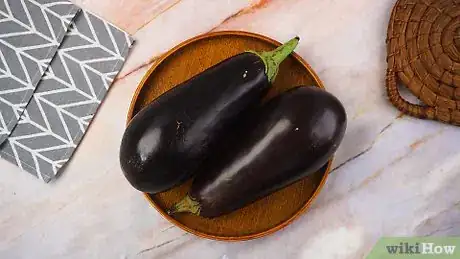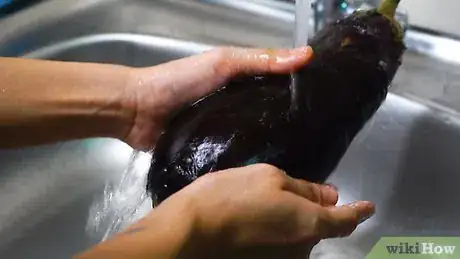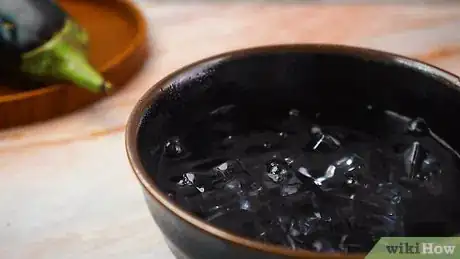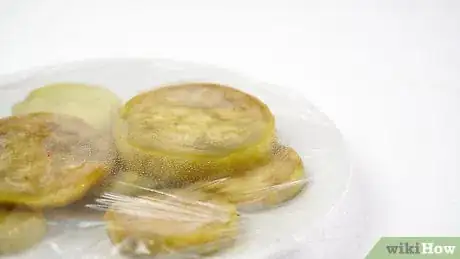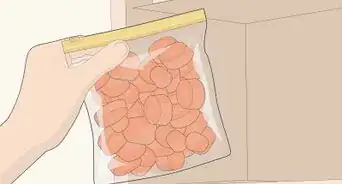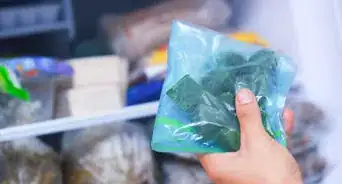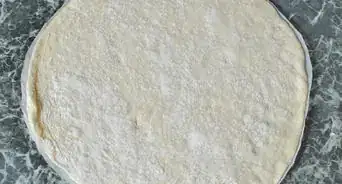wikiHow is a “wiki,” similar to Wikipedia, which means that many of our articles are co-written by multiple authors. To create this article, 13 people, some anonymous, worked to edit and improve it over time.
The wikiHow Culinary Team also followed the article's instructions and verified that they work.
This article has been viewed 366,334 times.
Learn more...
Eggplant can be frozen if you intend to cook it after thawing it out. To freeze eggplant, you need to clean it, cut it into slices, and blanch it before placing it in the freezer. Alternatively, you can also freeze baked eggplant or slices of eggplant Parmesan. This article will guide you through the process for freezing eggplant, using each of these methods.
Steps
Preparing the Eggplant
-
1Select a fresh eggplant. The fresher an eggplant is, the better it will hold up after being frozen.
- Any eggplant you freeze should be ripe and the seeds should not yet be fully mature. Look for eggplants that have a uniformly dark hue.
- Do not use eggplants that have soft spots or mismatched patches of color.
- Traditional black varieties tend to break down less in the freezer than purple Chinese and Thai varieties, but all types can technically be frozen for later use. Just be aware of the fact that the flesh will become softer after being frozen, but this is not usually an issue if you plan on cooking the eggplant after thawing it.
- If you are unable to freeze the eggplant immediately, store it in the refrigerator until you are ready. The sooner you can freeze an eggplant after harvesting it, though, the better.
-
2Wash the eggplant. Rinse the eggplant under cold running water, scrubbing it gently with your fingers to remove dirt and residue.
- If you harvested the eggplant from your own garden and have a hard time removing the dirt, you may scrub it gently with a vegetable brush.
Advertisement -
3Cut the eggplant into slices. The eggplant should be separated into 1/3-inch (8.5-mm) thick skinless slices.[1]
- Use a sharp knife to cut off 1/4-inch (6.35-mm) from the top and bottom of the eggplant.
- Use a vegetable peeler to remove the skin. Stand the eggplant on one of its newly cut flat ends and peel the vegetable from top to bottom.
- Use a sharp knife to cut the remaining eggplant into slices that measure about 1/3-inch (8.5-mm) each.
- Work quickly, and only cut as much eggplant as you are able to blanch at a time. Cut eggplant will begin to discolor after 30 minutes.
Blanching the Eggplant
-
1Boil water in a large stockpot. Roughly 2/3 of the pot should be filled with water. Set it to boiling on the stove over high heat.
- Give the water ample time to reach a rolling boil.
- Make sure that your pot is large enough to fit all the eggplant you've already cut up. You can blanch the eggplant in batches if you do not have any stockpots large enough to fit all your eggplants, but you should only cut up as much eggplant at a time as you can blanch in one batch.
-
2
-
3Prepare a large bowl of ice water. The bowl of water should be about as large as the stockpot used to blanch the eggplants.
- Use a tray or more of ice to make sure that the water is plenty cold.
- Make sure that the cold water is ready before you begin blanching the eggplant.
-
4Blanch the eggplant. Place the eggplant slices in the boiling water and blanch them for 4 minutes.[4]
- Blanching destroys enzymes in the eggplant that cause the vegetable to break down over time. If you do not blanch the eggplant, it will begin losing nutritional value, color, and flavor within a month, even if you freeze it.
- You can safely use the same water to blanch multiple batches of eggplant up to five times. You may need to add more water and lemon juice as the water level dips, however.
-
5Quickly transfer the eggplant to the ice water. As soon as the eggplant has been blanched, use a slotted spoon to remove the slices from the boiling water and dunk them into the ice water.
- By rapidly cooling the eggplant, you stop the cooking process.
- Allow the eggplant slices to sit in the ice water 4 to 5 minutes or until cold to the touch.
- Add more ice and water to the bowl as necessary to maintain the right temperature.
-
6Drain the eggplant slices. Remove them from the ice water with a slotted spoon and drain them in a colander or on several layers of clean paper towels.
Freezing the Eggplant
-
1Place the eggplant slices in a freezer-safe container. You can either use a freezer-safe plastic resealable bag or a freezer-safe plastic container.
- If packing the eggplant in freezer-safe plastic bags, remove as much air as possible from the bag to prevent freezer burn. Vacuum sealed bags are the best option, but you can still use standard resealable plastic bags as long as they are approved for freezer use.
- If packing the eggplant in freezer-safe plastic containers, leave at least 1/2-inch (1.27-cm) empty headspace at the top of the container. This extra space allows the eggplant room to expand as it freezes.[5]
- Glass containers are not recommended for freezer use.
- Label the bag or container with the current date so that you will know, in the future, how long your batch of eggplant has been sitting in the freezer.
-
2Separate slices with plastic wrap or freezer wrap, if desired.[6] If you plan on using the eggplant slices separately in the future, you should layer well-drained slices with alternating layers of plastic wrap or freezer paper.
- This step is only optional, but if you do not take this precaution, the slices will stick together upon freezing.
-
3Freeze until ready to use. Typically, frozen eggplant stays good for about 9 months.
- Vacuum-sealed eggplant that is deep frozen will will retain its quality for about 14 months.
Alternative Methods
-
1Bake the eggplant before freezing it. Another way to freeze eggplant is in pre-cooked form.[7]
- Preheat the oven to 400 degrees Fahrenheit (204 degrees Celsius). Prepare a shallow baking sheet by covering it with aluminum foil.
- Use a fork to prick the eggplant multiple times. Pricking the eggplant prevents pressure from building up inside of it as it bakes. The more holes you create, the safer it will be.
- Roast the eggplant 30 to 60 minutes. The eggplant is ready once it begins to collapse inside the oven. Smaller eggplants will only take 30 minutes, but larger ones may take up to an hour.
- Scoop out the flesh. When the eggplant is cool to the touch, cut it open lengthwise using a knife. Use a metal spoon to dig out the flesh.
- Pack the flesh into airtight containers. Leave 1/2-inch (1.27-cm) headspace in each container.
- Freeze up to 12 months.
-
2Prepare slices for eggplant Parmesan. If you plan on using the eggplant for eggplant Parmesan, you can coat the eggplant slices in breadcrumbs and freeze without baking it.
- Wash and slice the eggplant as you would if freezing plain, blanched slices.
- Dip each slice in milk, beaten egg, or frying batter.
- Coat the slices in a mixture of seasoned bread crumbs. The bread crumbs can be seasoned with Italian herbs, Parmesan cheese, or left as plain, dry bread crumbs.
- Wrap the slices in wax paper. Instead of merely layering the slices between pieces of plastic wrap, make sure that each breaded slice is completely wrapped in its own sheet of wax paper.
- Freeze up to 6 months.
- To use, thaw the slices in the refrigerator and bake or fry them as you usually would.
References
- ↑ https://www.thekitchn.com/this-is-the-best-way-to-freeze-eggplant-233591
- ↑ http://nchfp.uga.edu/how/freeze/eggplant.html
- ↑ https://garden.org/learn/articles/view/537/
- ↑ https://nchfp.uga.edu/how/freeze/eggplant.html
- ↑ https://nchfp.uga.edu/how/freeze/eggplant.html
- ↑ https://www.pickyourown.org/freezingeggplant.htm
- ↑ http://www.seriouseats.com/recipes/2010/07/the-crisper-whisperer-how-to-handle-eggplant-overload-caponata-recipe.html
Community Q&A
-
QuestionCan I use citric acid instead of lemon juice to prepare eggplant?
 Community AnswerYes you can, but keep in mind you will have a different flavor. Lime and orange juice are really good choices.
Community AnswerYes you can, but keep in mind you will have a different flavor. Lime and orange juice are really good choices. -
QuestionCan I freeze eggplant without cooking it?
 Community AnswerAll vegetables require some amount of cooking for the best results, usually blanching. This allows for separation of its moisture from its tissue, which diminishes possibility of a runny or watery dish.
Community AnswerAll vegetables require some amount of cooking for the best results, usually blanching. This allows for separation of its moisture from its tissue, which diminishes possibility of a runny or watery dish. -
QuestionCan you bread eggplant after it has been frozen?
 Community AnswerNo, the cells loose their life once you freeze.
Community AnswerNo, the cells loose their life once you freeze.
Things You'll Need
- Sharp kitchen knife
- Vegetable peeler
- Vegetable brush
- Large stockpot
- Large bowl
- Freezer-safe container or bag
- Plastic wrap or freezer wrap
- Baking sheet
- Aluminum foil
- Fork
- Oven mitts
- Wax paper
About This Article
To freeze eggplant, start by cutting it into slices. Then, bring a pot of water and lemon juice to a boil, and add the eggplant to the pot. Blanch the eggplant for 4 minutes, then transfer it directly to a bowl of ice water to stop the cooking process. After the slices have been in the water for 5 minutes, drain them on paper towels. Then, place the slices in a freezer-safe container and freeze for up to 9 months. If you plan to use the slices separately, divide them up with layers of plastic wrap so they don't stick together. To learn how to freeze eggplant parmesan slices, read on!
